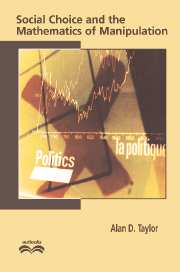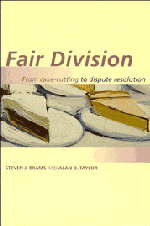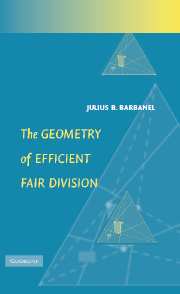Social Choice and the Mathematics of Manipulation
Honesty in voting, it turns out, is not always the best policy. Indeed, in the early 1970s, Allan Gibbard and Mark Satterthwaite, building on the seminal work of Nobel laureate Kenneth Arrow, proved that with three or more alternatives there is no reasonable voting system that is non-manipulable; voters will always have an opportunity to benefit by submitting a disingenuous ballot. The ensuing decades produced a number of theorems of striking mathematical naturality that dealt with the manipulability of voting systems. This 2005 book presents many of these results from the last quarter of the twentieth century, especially the contributions of economists and philosophers, from a mathematical point of view, with many new proofs. The presentation is almost completely self-contained, and requires no prerequisites except a willingness to follow rigorous mathematical arguments. Mathematics students, as well as mathematicians, political scientists, economists and philosophers will learn why it is impossible to devise a completely unmanipulable voting system.
- This is the only book that tries to bring together the main results from the last quarter of the twentieth century that deal with the manipulability of voting systems
- This is a unified treatment; a vast majority of the proofs are new
- This is a self-contained treatment; there are no prerequisites except a willingness to follow mathematical arguments
Reviews & endorsements
'… well organised and clearly written, with subtle differences in similar situations being deftly dealt with. In conclusion, this book is a little gem. It will be especially prized by those who need to understand voting systems and how they can be manipulated by individual voters.' Mathematics Today
'Overall, I think this book is the must-have-on-the-shelf for scholars interested in social choice, including economists, philosophers, mathematicians, and political scientists. If a reader takes the effort to go through the book thoroughly, the benefits, in my opinion, would be enormous.' Psychometrika
Product details
July 2005Paperback
9780521008839
190 pages
229 × 153 × 17 mm
0.272kg
3 b/w illus. 80 exercises
Available
Table of Contents
- 1. Introduction
- 2. The Gibbard–Satterthwaite theorem
- 3. Additional results for single-valued elections
- 4. The Duggan–Schwartz theorem
- 5. Additional results for multi-valued elections
- 6. Ballots that rank sets
- 7. Elections with outcomes that are lotteries
- 8. Elections with variable agendas
- References
- Index.




